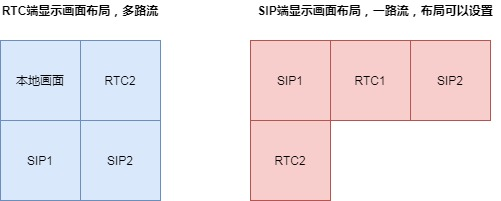1 Background
2 Comparison between hardware video conference and RTC cloud conference
3 SIPGateway
Architecture diagram
-
SIP protocol access module: used to realize the access of SIP users and support RTP/RTCP protocol; -
Yunxin RTC protocol access module: used to realize the access of Yunxin RTC users and support the private protocol of Yunxin RTC; -
Conference management module: mainly maintain the status of rooms and participants, conference number management, etc; -
Encoding and decoding module: mainly deal with audio and video encoding and decoding and transcoding; -
MCU module: SIPGateway realizes the function of mixing sound and screen. Since SIP standard terminal does not support the ability of Simulcast, nor does it support receiving multiple streams, it needs to do mixed screen mixing on SIPGateway and send it to SIP terminal; -
SFU module: support pure forwarding mode or select forwarding mode according to voice excitation;
Instance application scenario
-
After the SIP user logs in, the SIP Gateway synchronously creates the room and manages the user status; -
When the user joins the conference, it is a SIP user, SIPGateway will simulate this SIP user as an RTC user and then join NetEase conference This is the NERTC process. After establishing the uplink RTCSession with the media server, you can push the stream, The upstream stream of the SIP end will be copied to the media server while the MCU mixed screen mixing is performed on the SIP Gateway The advantage of this is that the media service does not need special processing for SIP users, thus reducing its intrusion; -
When RTC users log in to the conference, SIPGateway simulates the RTC user as a SIP user and adds it to the room on the gateway At the same time, it establishes a downlink RTCSession with the media server to receive the stream, and the media stream of RTC users is forwarded to SIP users through the mixing screen;
-
In terms of audio, PSTN/SIP generally uses G.722 or G.729 codec, while the NERTC system uses OPUS codec, so the audio needs transcoding; -
In terms of video, MCU function is introduced. The process will have a certain impact on the server performance, but the overall performance meets the expectations;

-
When the hardware video conference creates a room, NetEase conference APP will call the hardware video conference number, and create NetEase conference room and SIP gateway SIP conference short number synchronously; -
After creating the SIPGateway room, the screen will be fused in the gateway conference room; -
When the user joins the conference, it is an RTC user. SIPGateway will simulate a SIP user to join the gateway conference room, and establish a downlink RTCSession with the media server to receive streams; -
The overall strategy of SIPGateway is Through smart signaling conversion, all users in the hardware video conference are simulated as one RTC user to join NetEase conference All RTC users are simulated as a SIP user to join the hardware video conference; -
SIPGateway pushes video images, According to the energy routing strategy, select the RTC user video stream with the largest sound energy , fuse the screen and send it to the hardware video; -
SIP layout screen can be set by hardware video conference control, and can be changed by switching between SIP main venue and branch venue and polling, and can also selectively view the screen of one RTC or all RTC participants; -
RTC joins the hardware video conference scene to achieve real conference interconnection. SIP end users can join both hardware video conference rooms and NetEase conference rooms;

4 Features and deployment of SIPGateway
Features of SIPGateway
Flexible incoming call mode
-
Support PSTN/SIP end to actively join NetEase conference. NetEase conference also assigns a corresponding SIP conference short number to the SIP terminal when it creates the conference. SIP users can join NetEase conference only by entering the SIP conference short number; -
Support inviting PSTN/SIP end to join NetEase conference. During the conference, the host selects the SIP terminal in the address book and actively invites him to join the conference; -
Support NetEase conference APP to join the third-party video conference system;
Full platform interoperability
-
Support interoperability with iOS, Android, PC and Mac platforms; -
Support PSTN/SIP terminal access;
MCU cascade
load balancing
High security
-
IP whitelist: The proxy at SIPGateway is the proxy for the SIP terminal's membership request. To prevent malicious attacks, we set an IP whitelist for the tenant to prevent illegal IP access; -
Regional isolation: different tenants can route to the same SIPGateway, or to a special SIPGateway or cluster; -
For enterprises with high network security requirements, SIP proxy is deployed in the DMZ area of the enterprise, which serves as the protection of the enterprise intranet, prevents intranet attacks, and can also communicate with the external network;
High availability
-
SIPGateway adopts cluster deployment. When one SIPGateway goes down, audio and video calls of other users will not be affected; -
SIP Proxies are kept alive through Keep Alive. When one proxy goes down, it will switch to the other proxy, which will not affect the SIP call status and user audio and video calls, so as to achieve sensorless switching;
Data monitoring platform
-
Data platform: collect the online status, traffic status and network status of SIP users on a regular basis, which helps to locate and analyze problems in time in case of abnormalities; -
Monitoring platform: automatically monitors the status of the server. When the service is abnormal, an alarm will pop up automatically, which helps to solve the service exception problem in a timely manner;
Deployment mode of SIPGateway
5 Conclusion
-
MCU : One of the multi person communication architectures, multi-point control unit, which is characterized by the server mixing all the upstream media streams into one path and transferring them to the receiver; -
SFU : As one of the multi person communication architectures, the forwarding unit is selected, which is characterized by that the server forwards each subscribed upstream stream to the receiving end, instead of mixing streams; -
SIP protocol : short for Session Initiation Protocol, the protocol standard in the communication field; -
RTCSession: RTC streaming component of NetEase Yunxin; -
Simulcast : Multi stream transmission, that is, the same terminal is allowed to send video streams of different resolution gears at the same time; -
NERTC: audio and video communication scheme developed by Netease Yunxin; -
SIPGateway: SIP protocol access gateway;














































